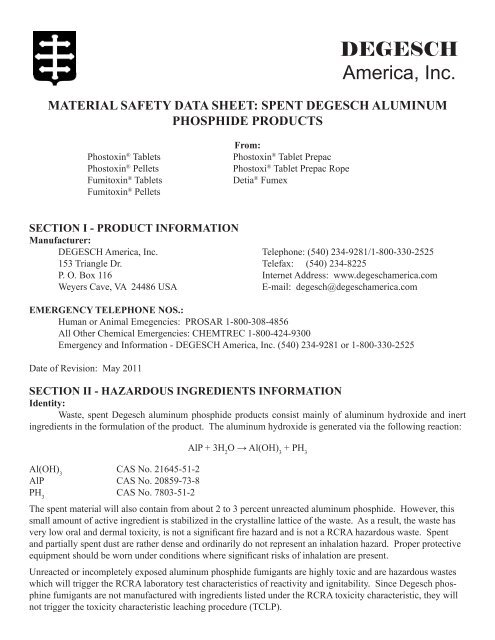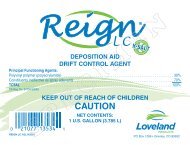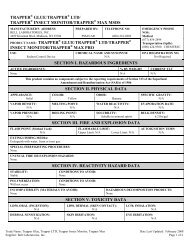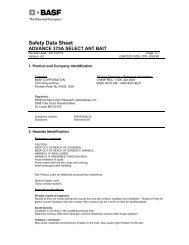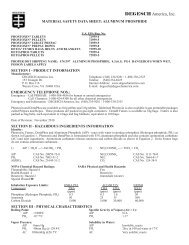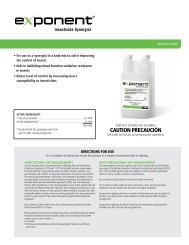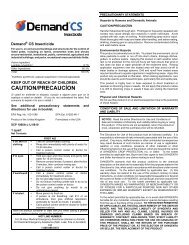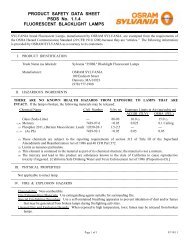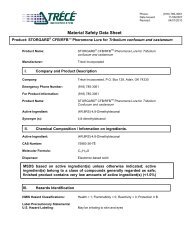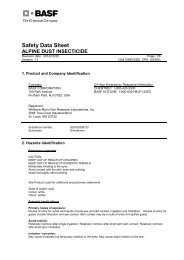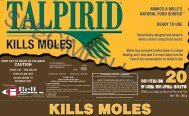Spent Aluminum Phosphide MSDS - Wil-Kil Pest Control
Spent Aluminum Phosphide MSDS - Wil-Kil Pest Control
Spent Aluminum Phosphide MSDS - Wil-Kil Pest Control
You also want an ePaper? Increase the reach of your titles
YUMPU automatically turns print PDFs into web optimized ePapers that Google loves.
DEGESCHAmerica, Inc.MATERIAL SAFETY DATA SHEET: SPENT DEGESCH ALUMINUMPHOSPHIDE PRODUCTSPhostoxin ® TabletsPhostoxin ® PelletsFumitoxin ® TabletsFumitoxin ® PelletsFrom:Phostoxin ® Tablet PrepacPhostoxi ® Tablet Prepac RopeDetia ® FumexSECTION I - PRODUCT INFORMATIONManufacturer:DEGESCH America, Inc. Telephone: (540) 234-9281/1-800-330-2525153 Triangle Dr. Telefax: (540) 234-8225P. O. Box 116 Internet Address: www.degeschamerica.comWeyers Cave, VA 24486 USAE-mail: degesch@degeschamerica.comEMERGENCY TELEPHONE NOS.:Human or Animal Emegencies: PROSAR 1-800-308-4856All Other Chemical Emergencies: CHEMTREC 1-800-424-9300Emergency and Information - DEGESCH America, Inc. (540) 234-9281 or 1-800-330-2525Date of Revision: May 2011SECTION II - HAZARDOUS INGREDIENTS INFORMATIONIdentity:Waste, spent Degesch aluminum phosphide products consist mainly of aluminum hydroxide and inertingredients in the formulation of the product. The aluminum hydroxide is generated via the following reaction:Al(OH) 3CAS No. 21645-51-2AlP CAS No. 20859-73-8PH 3CAS No. 7803-51-2AlP + 3H 2O → Al(OH) 3+ PH 3The spent material will also contain from about 2 to 3 percent unreacted aluminum phosphide. However, thissmall amount of active ingredient is stabilized in the crystalline lattice of the waste. As a result, the waste hasvery low oral and dermal toxicity, is not a significant fire hazard and is not a RCRA hazardous waste. <strong>Spent</strong>and partially spent dust are rather dense and ordinarily do not represent an inhalation hazard. Proper protectiveequipment should be worn under conditions where significant risks of inhalation are present.Unreacted or incompletely exposed aluminum phosphide fumigants are highly toxic and are hazardous wasteswhich will trigger the RCRA laboratory test characteristics of reactivity and ignitability. Since Degesch phosphinefumigants are not manufactured with ingredients listed under the RCRA toxicity characteristic, they willnot trigger the toxicity characteristic leaching procedure (TCLP).
ACGIH Exposure Limits:Phosphine: TLV/TWA 0.3 ppm PH 3, TLV/STEL 1.0 ppm PH 3<strong>Aluminum</strong> Oxide Dust: TLV/TWA 10mg/m 3Toxicity:Acute Oral ToxicityAcute Dermal ToxicityNFPA Chemical Hazard Ratings:Flammability Hazard 1Health Hazard 0Reactivity Hazard 1Special Hazard NoneLD 50= 3000 mg/kgLD 50> 5000 mg/kgSARA Physical and Health Hazards:NoneSECTION III - PHYSICAL CHARACTERISTICS OF ALUMINUM PHOSPHIDEBoiling Point: >1000 o CVapor Pressure: 0mm Hg @25 o CDensity: 2.4g/ccSolubility in Water: insolubleSolubility in Acid and Base: very soluble and will liberate small amounts of phosphineAppearance and Odor:<strong>Spent</strong> Degesch aluminum phosphide products are a slight grayish-white in color. They are generally odorless,however, they may have a faint garlic or decaying fish odor due to traces of phosphine being evolved.SECTION IV - FIRE AND EXPLOSION HAZARD DATAFlash Point: >800 o CExtinguishing Media: n/a, not flammableSpecial Fire Fighting Procedures: n/aRespiratory Protection:None required. Use NIOSH/MSHA approved dust mask if spent dust becomes airborne.Protective Clothing:Wear gloves when handling aluminum phosphide or its spent dustUnusual Fire and Explosion Hazards:None, under ordinary circumstances. However, spent dust will liberate small amounts of phosphine whenreacted with acids or bases. The phosphine, if it allowed to concentrate in a confined area, may be toxic and/orflammable.SECTION V - REACTIVITY DATAStability:<strong>Spent</strong> aluminum phosphide dusts are stable under most conditions. However, the dust will liberatephosphine if contacted by acids, bases or boiling water.Incompatibility:None, except as described under Stability.Corrosion:None.Hazardous Polymerization:<strong>Wil</strong>l not occur.
SECTION VI - HEALTH HAZARD INFORMATIONRoutes of Entry:The primary route of exposure is dermal. However, ingestion and inhalation exposures are also possible. <strong>Spent</strong>dust from Degesch aluminum phosphide products has very low oral and dermal toxicity. This small risk may beavoided by the use of cloth gloves when handling the material, as required by EPA-approved labeling. Accidentalingestion is avoided by washing, prior to eating, after handling phosphine fumigants. The risk of any significantinhalation is very small because of the high density of the spent dust and its low toxicity.Acute and Chronic Health Hazards:Exposure to phosphine at levels up to worker protection limits will not cause any acute effects orcarcinogenicity or other chronic health effects. <strong>Spent</strong> dust has very low acute toxicity via the dermal or oralexposure routes and it is believed to have no chronic toxicity.Carcinogenicity:Phostoxin and Fumex are not carcinogenic and aluminum phosphide and other ingredients of spent dustfrom Degesch fumigants are not known to be carcinogenic.Signs and Symptoms of Exposure:There are no signs or symptoms of exposure to spent dust at levels likely to be encountered.Emergency and First Aid Procedures:Usually no emergency or first aid procedures are required due to the low toxicity of the spent dust. However,recommended procedures for dealing with overexposures from unreacted aluminum phosphide and phosphineare given below.If the gas or dust from aluminum phosphide is inhaled:Move person to fresh air. If person is not breathing, call 911 or an ambulance, then give artificial respiration,preferably by mouth-to-mouth, if possible. Call a poison control center or doctor for further treatment advice.If aluminum phosphide pellets, tablets or powder are swallowed:Call a poison control center or doctor immediately for treatment advice. Have person sip a glass of waterif able to swallow. Do not induce vomiting unless told to by a poison control center or doctor. Do not giveanything by mouth to an unconscious person.If powder or granules of aluminum phosphide get on skin or clothing:Take off contaminated clothing. Rinse skin immediately with plenty of water for 15-20 minutes. Call apoison control center or doctor for treatment advice. Brush or shake material off clothes in a well-ventilated area.Allow clothes to aerate in a ventilated area prior to laundering. Do not leave contaminated clothing in occupiedand/or confined areas such as automobiles, vans, motel rooms, etc.If dust from pellets or tablets gets in eyes:Hold eye open and rinse slowly and gently with water for 15-20 minutes. Remove contact lenses ifpresent, after the first 5 minutes, then continue rinsing eye. Call a poison control center or doctor for furthertreatment advice.SECTION VII - PRECAUTIONS FOR SAFE HANDLINGAvoid contact with spent dust by using cloth gloves when handling this material. Avoid inhalation of thespent dust. NIOSH/MSHA approved dust masks should be worn if inhalation of the dust is likely to occur.
For Assistance:Contact - DEGESCH America, Inc.Telephone: (540) 234-9281 or 1-800-330-2525Telefax: (540) 234-8225Internet address: www.degeschamerica.comE-Mail: degesch@degeschamerica.comorPROSAR for Human or Animal Emergencies: 1-800-308-4856CHEMTREC for All Other Chemical Emergencies: 1-800-424-9300Disposal of <strong>Spent</strong> Phostoxin:When being disposed of, spilled or partially reacted Degesch aluminum phosphide fumigants are hazardouswastes under existing Federal Regulations. If properly exposed, the grayish-white residual dust after a fumigationwill not be a hazardous waste and normally contains only a very small amount of unreacted aluminum phosphide.This waste will be safe for disposal. However, the residual dust from incompletely exposed products may requirespecial care.Triple rinse flasks and stoppers with water or dry deactivate them by exposure to open air for 24 hours orlonger. Then offer for recycling or reconditioning, or puncture and dispose of in a sanitary landfill, or by otherprocedures approved by state and local authorities. Rinsate may be disposed of in a storm sewer, sanitary landfillor by other approved procedures. Or, it is permissible to remove lids and expose empty flasks to atmosphericconditions until the residue in the flasks is reacted. Then puncture and dispose of in a sanitary landfill or otherapproved site, or by other procedures approved by state and local authorities.Some local and state waste disposal regulations may vary from the above recommendations. Disposalprocedures should be reviewed with appropriate authorities to ensure compliance with local regulations. Contactyour State <strong>Pest</strong>icide or Environmental <strong>Control</strong> Agency or Hazardous Waste Specialist at the nearest EPA RegionalOffice for guidance.See Degesch America, Inc. <strong>MSDS</strong> for <strong>Aluminum</strong> <strong>Phosphide</strong> fumigants for recommendations on disposaland handling unreacted or incompletely reacted fumigant.SECTION VIII - CONTROL MEASURESRespiratory Protection:NIOSH/MSHA approved respiratory protection for dusts may be used when inhalation exposure to spentdust is likely to occur.Protective Clothing:Wear cloth gloves when handling spent dust from aluminum phosphide fumigants.Eye Protection:None required.We believe the statements, technical information and recommendations contained herein are reliable,but they are given without warranty or guarantee of any kind, expressed or implied, and we assume noresponsibility for any loss, damage, or expense, direct or consequential, arising out of their use.


